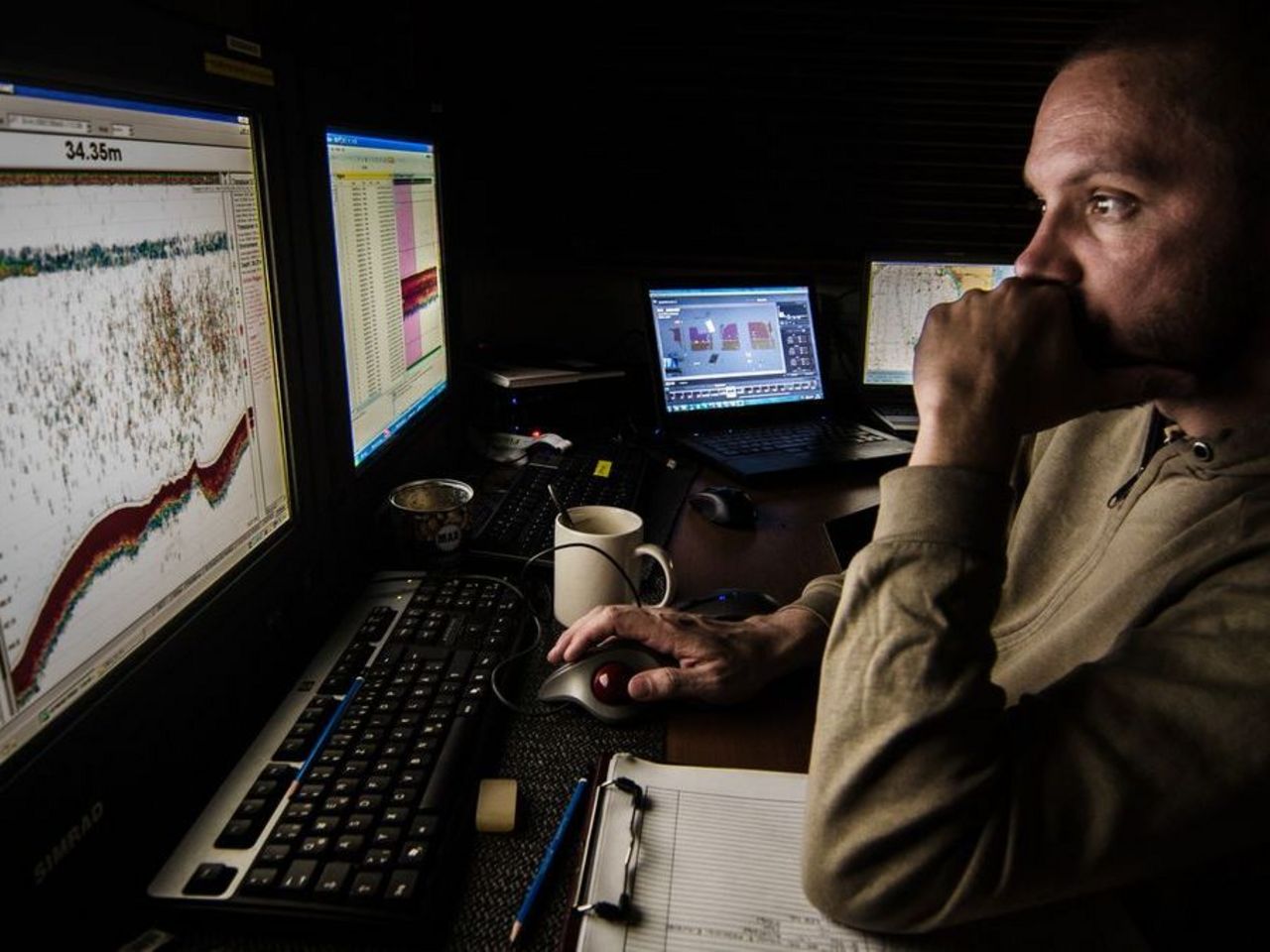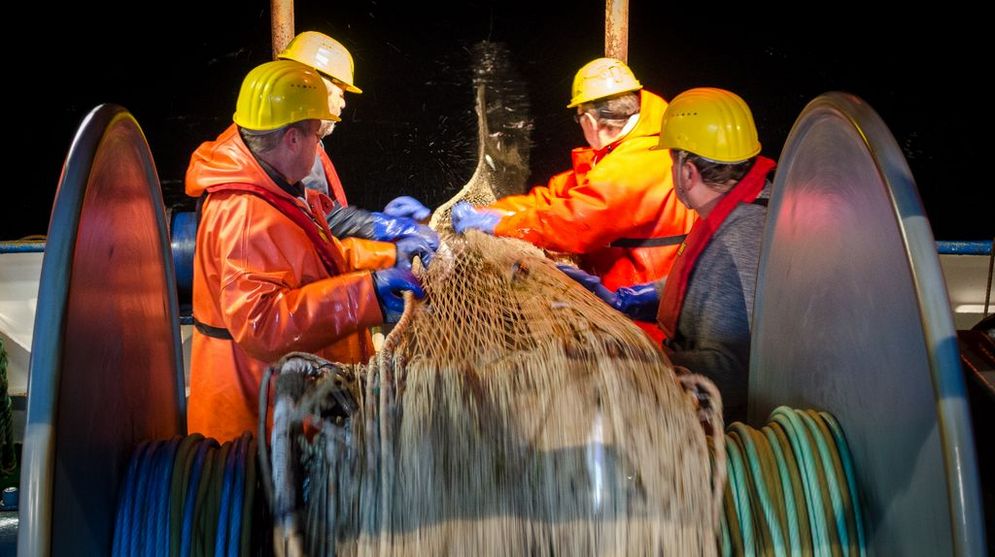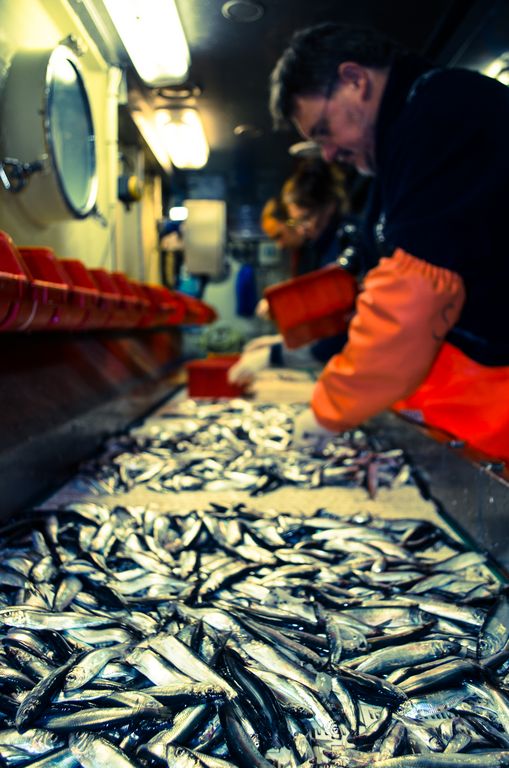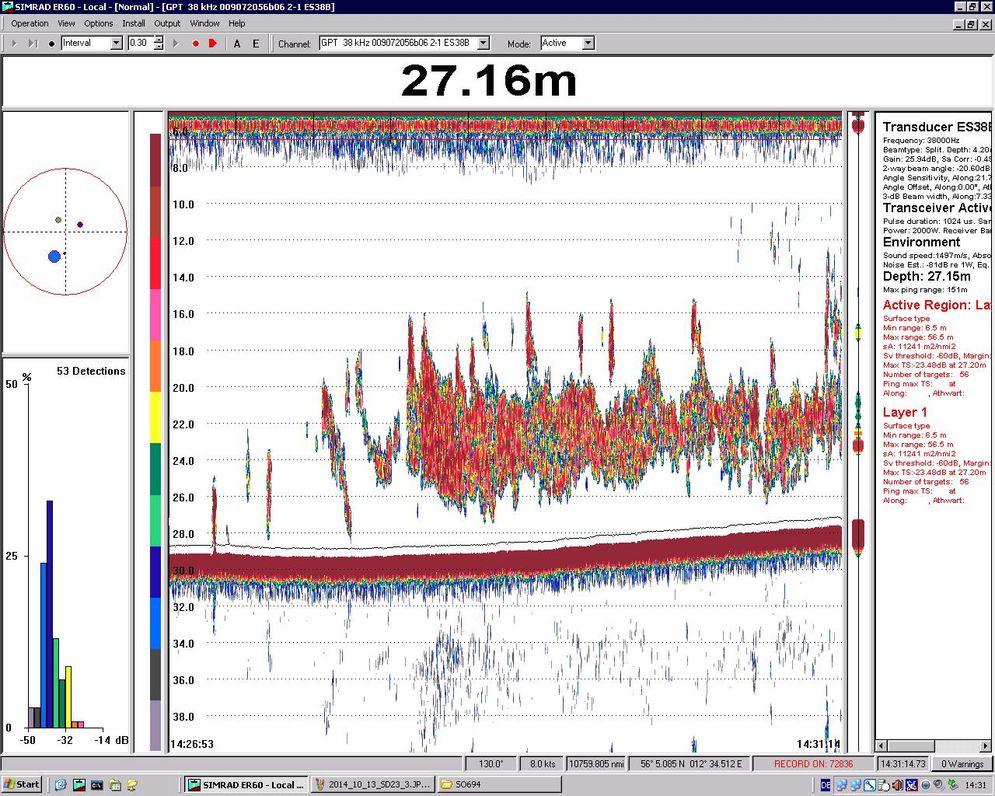Project
What are they? And how many are they?

Hydroacoustic monitoring of fish stocks to determine stock parameters and distribution patterns
Hydroacoustic methods utilize sound waves to detect marine organisms. Modern echosounders can not only be used to determine stock parameters but also allow identification of habitat use, species composition and further parameters of marine ecosystems. These data are the basis for predictive models allowing estimating sustainable catch quotas.
Background and Objective
Hydroacoustic monitoring methods allow direct determination of stock parameters and distribution patterns of (mainly) pelagic fish species. To utilize these parameters as a basis for predictive models estimating sustainable catch quantitites and to allow conclusions on distribution patterns and habitat use of different fish species, spatially highly resolving surveys of corresponding areas are required. Further, by concurrently measuring environmental parameters, estimates on distribution patterns and habitat preferences or habitat usage of different fish species can be made.
Target Group
Policy-makers in marine environmental as well as common fisheries policy; Fisheries scientists; interested community
Approach
Within the framework of international surveys that are coordinated by the International Council for the Exploration of the Sea (ICES) we participate in surveys monitoring abundance indices of important fish stocks in the North Sea, Baltic Sea and Northeast Atlantic. On predefined hydroacoustic transects in the survey area data on echo distribution and total echo strength are collected, together with environmental parameters (temperature, salinity etc.). Based on total echo strenght/distribution, on species composition and corresponding length frequency distributions from targeted pelagic trawl hauls and based on backscattering characteristics of different fish species we are able to provide spatially highly resolved data on abundance, biomass and age structure of e.g. herring, sprat, blue whiting and redfish. These data are further used in internationally coordinated assessments of status and sustainable use of the corresponding stocks.


Data and Methods
Hydroacoustic data are collected with modern scientific multifrequency echosounders.
Our Research Questions
How can hydroacoustic data be used to estimate abundances and distribution patterns of different marine species? What is the status of different (pelagic) fish stocks?
Preliminary Results
Estimates of biomass, abundance, age structure and distribution of pelagic fish stocks in the North Sea, Baltic Sea and North Atlantic
Links and Downloads
Thünen-Contact

Involved Thünen-Partners
Duration
1.2001 - 12.2027
More Information
Project status:
ongoing
Publications
- 0
Scoulding B, Gastauer S, Taylor JC, Boswell KM, Fairclough DV, Jackson G, Sullivan P, Shertzer K, Campanella F, Bacheler N, Campbell M, Domokos R, Schobernd Z, Switzer TS, Jarvis N, Crisafulli BM, Untiedt C, Fernandes PG (2023) Estimating abundance of fish associated with structured habitats by combining acoustics and optics. J Appl Ecol 60(7):1274-1285, DOI:10.1111/1365-2664.14412
- 1
Yang Y, Gastauer S, Proud R, Mangeni-Sande R, Everson I, Kayanda RJ, Brierley AS (2023) Modelling and in situ observation of broadband acoustic scattering from the Silver cyprinid (Rastrineobola argentea) in Lake Victoria, East Africa. ICES J Mar Sci: in Press, DOI:10.1093/icesjms/fsad137
- 2
Bairstow F, Gastauer S, Wotherspoon S, Brown CTA, Kawaguchi S, Edwards T, Cox MJ (2022) Krill biomass estimation: Sampling and measurement variability. Front Mar Sci 9:903035, DOI:10.3389/fmars.2022.903035
- 3
Jech M, Schaber M, Gastauer S, Alegria N, Algroy T, Andersen LN, Anderson C, Annasawmy AP, Arendt C, Ariza A, Barbin L, Berger L, Boyra G, Brehmer P, Bristow M, Calise L, Carlsen A, Cermak J, Chawarski J, Chu D, et al (2022) Working Group of Fisheries Acoustics, Science and Technology (WGFAST). Copenhagen: ICES, 93 p, ICES Sci Rep 4(54), DOI:10.17895/ices.pub.20178464
- 4
Gröhsler T, Schaber M (2014) Annex 6: Cruise reports from other acoustic surveys in the area : Annex 6a: Western Baltic acoustic survey ; Survey report for FRV "Solea" ; German Acoustic Autumn Survey (GERAS), 30 September 2013 - 19 October 2013. In: Report of the Working Group of International Pelagic Surveys (WGIPS) ; 20-24 January 2014. Copenhagen: ICES, pp 224-251
- 5
Gröhsler T, Schaber M (2014) Survey Report for FRV "Solea" German Acoustic Autumn Survey (GERAS) 30 September 2013 - 19 October 2013. In: Report of the Baltic International Fish Survey Working Group (WGBIFS) : 24-28 March 2014 ; Gdynia, Poland. Copenhagen: ICES, pp 250-258
- 6
Planque B, Kristinsson K, Astakhov A, Bernreuther M, Bethke E, Drevetnyak K, Nedreaas K, Reinert J, Rolskiy A, Sigurdsson T, Stransky C (2013) Monitoring beaked redfish (Sebastes mentella) in the North Atlantic, current challenges and future prospects. Aquatic Liv Res 26(4):293-306, doi:10.1051/alr/2013062
- 7
Schaber M, Gröhsler T (2013) Survey Report for FRV "Solea" 2-21 October 2012. In: Report of the Baltic International Fish Survey Working Group (WGBIFS) : Annex 8: Cruise reports of acoustic surveys BASS and BIAS in 2012. Copenhagen: ICES, pp 266-289
- 8
Bethke E, Götze E, Planque B (2010) Estimation of the catchability of redfish and blue whiting for survey trawls in the Norwegian Sea. J Appl Ichthyol 26:47-53, DOI:10.1111/j.1439-0426.2010.01446.x

![[Translate to English:] [Translate to English:]](/media/_processed_/7/1/csm_IMG_7977_large_1defaf5de1.jpg)



![[Translate to English:] Logo des Bundesministerium für Ernährung und Landwirtschaft](/media/allgemein/logos/BMEL_Logo.svg)